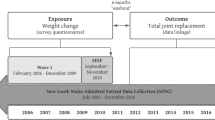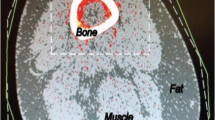Abstract
This study aims to assess whether older adults with low muscle mass or strength, in the presence of obesity, have an increased risk of knee (TKR) and hip replacement (THR) over 13 years. 1082 community-dwelling older adults (51% women; mean age 62.9 ± 7.5 years) were studied at baseline and multiple time points over 13 years. The incidence of TKR and THR was determined by data linkage to National Joint Replacement Registry. Appendicular lean and fat mass were measured using DXA. Lower-limb muscle strength (LMS) was assessed by dynamometer. Low muscle mass and strength were defined as the lowest sex-specific tertiles for appendicular lean mass (adjusted for height and total body fat mass) and lower-limb strength, respectively. Obesity was defined as the highest sex-specific tertile for total body fat mass. Competing risk regression models were used to estimate the sub-distribution hazard ratio (SHR) for TKR and THR. Over 13 years of follow-up, 6.8% (n = 74/1082) of the participants had a TKR and 4.7% (n = 50/1066) had THR. Participants with the combination of obesity and low muscle strength (SHR 3.36, 95% CI 1.50, 7.53) but low muscle mass (SHR 1.11, 95% CI 0.52, 2.40) had a significantly increased risk of TKR, compared to individuals with neither obesity nor low muscle mass/strength. However, obesity with low muscle strength did not lead to a significantly greater risk of TKR compared to having low muscle strength or obesity alone. There was no evidence for an association between obesity with low muscle mass or strength and THR (all p > 0.05). This finding suggests that combining muscle and fat assessments to predict the future risk of TKR is no better than each condition on its own.



Similar content being viewed by others
Data Availability
Data are available upon request.
References
Arthritis and Osteoporosis Victoria (2013) A problem worth solving The rising cost of musculoskeletal conditions in Australia. Arthritis and Osteoporosis Victoria, Melbourne
Leyland KM, Judge A, Javaid MK, Diez-Perez A, Carr A, Cooper C et al (2016) Obesity and the relative risk of knee replacement surgery in patients with knee osteoarthritis: a prospective cohort study. Arthritis Rheumatol 68(4):817–825
Culvenor AG, Wirth W, Ruhdorfer A, Eckstein F (2016) Thigh muscle strength predicts knee replacement risk independent of radiographic disease and pain in women: data from the osteoarthritis initiative. Arthritis Rheumatol 68(5):1145–1155
Wang Y, Wluka AE, Berry PA, Siew T, Teichtahl AJ, Urquhart DM et al (2012) Increase in vastus medialis cross-sectional area is associated with reduced pain, cartilage loss, and joint replacement risk in knee osteoarthritis. Arthritis Rheumatol 64(12):3917–3925
Kalinkovich A, Livshits G (2017) Sarcopenic obesity or obese sarcopenia: a cross talk between age-associated adipose tissue and skeletal muscle inflammation as a main mechanism of the pathogenesis. Ageing Res Rev 35:200–221
Lee S, Kim TN, Kim SH (2012) Sarcopenic obesity is more closely associated with knee osteoarthritis than is nonsarcopenic obesity: a cross-sectional study. Arthritis Rheumatol 64(12):3947–3954
Godziuk K, Prado CM, Woodhouse LJ, Forhan M (2018) The impact of sarcopenic obesity on knee and hip osteoarthritis: a scoping review. BMC Musculoskelet Disord 19(1):271
Misra D, Fielding RA, Felson DT, Niu J, Brown C, Nevitt M et al (2018) Risk of knee OA with obesity, sarcopenic obesity and sarcopenia. Arthritis Rheumatol 71:232–237
Wang X, Miller GD, Messier SP, Nicklas BJ (2007) Knee strength maintained despite loss of lean body mass during weight loss in older obese adults with knee osteoarthritis. J Gerontol Ser A 62(8):866–871
Clark BC, Manini TM (2008) Sarcopenia≠ dynapenia. J Gerontol Ser A 63(8):829–834
Graves SE, Davidson D, Ingerson L, Ryan P, Griffith EC, McDermott BF et al (2004) The Australian orthopaedic association national joint replacement registry. Med J Aust 180(5):S31
Scott D, Blizzard L, Fell J, Jones G (2011) Prospective associations between ambulatory activity, body composition and muscle function in older adults. Scand J Med Sci Sports 21(6):e168–e175
Scott D, Chandrasekara SD, Laslett LL, Cicuttini F, Ebeling PR, Jones G (2016) Associations of sarcopenic obesity and dynapenic obesity with bone mineral density and incident fractures over 5–10 years in community-dwelling older adults. Calcif Tissue Int 99(1):30–42
Scott D, Sanders KM, Aitken D, Hayes A, Ebeling PR, Jones G (2014) Sarcopenic obesity and dynapenic obesity: 5-year associations with falls risk in middle-aged and older adults. Obesity 22(6):1568–1574
Newman AB, Kupelian V, Visser M, Simonsick E, Goodpaster B, Nevitt M et al (2003) Sarcopenia: alternative definitions and associations with lower extremity function. J Am Geriatr Soc 51(11):1602–1609
Jones G, Ding C, Scott F, Glisson M, Cicuttini F (2004) Early radiographic osteoarthritis is associated with substantial changes in cartilage volume and tibial bone surface area in both males and females. Osteoarthr Cartil 12(1):169–174
Balogun S, Winzenberg T, Wills K, Scott D, Callisaya M, Jones G et al (2018) Longitudinal associations of serum 25-hydroxyvitamin D, physical activity, and knee pain and dysfunction with physiological falls risk. Exp Gerontol 73(4):526–531
Fine JP, Gray RJ (1999) A proportional hazards model for the subdistribution of a competing risk. J Am Stat Assoc 94(446):496–509
Austin PC, Fine JP (2017) Practical recommendations for reporting F ine-G ray model analyses for competing risk data. Stat Med 36(27):4391–4400
Mork PJ, Holtermann A, Nilsen TIL (2012) Effect of body mass index and physical exercise on risk of knee and hip osteoarthritis: longitudinal data from the Norwegian HUNT Study. J Epidemiol Community Health. https://doi.org/10.1136/jech-2011-200834
Segal NA, Findlay C, Wang K, Torner JC, Nevitt MC (2012) The longitudinal relationship between thigh muscle mass and the development of knee osteoarthritis. Osteoarthr Cartil 20(12):1534–1540
De Ceuninck F, Fradin A, Pastoureau P (2014) Bearing arms against osteoarthritis and sarcopenia: when cartilage and skeletal muscle find common interest in talking together. Drug Discov Today 19(3):305–311
Goodpaster BH, Chomentowski P, Ward BK, Rossi A, Glynn NW, Delmonico MJ et al (2008) Effects of physical activity on strength and skeletal muscle fat infiltration in older adults: a randomized controlled trial. J Appl Physiol 105(5):1498–1503
Daghestani HN, Kraus VB (2015) Inflammatory biomarkers in osteoarthritis. Osteoarthr Cartil 23(11):1890–1896
Reijman M, Pols H, Bergink A, Hazes J, Belo J, Lievense A et al (2007) Body mass index associated with onset and progression of osteoarthritis of the knee but not of the hip: the Rotterdam Study. Ann Rheum Dis 66(2):158–162
Lohmander LS, de Verdier MG, Rollof J, Nilsson PM, Engström G (2009) Incidence of severe knee and hip osteoarthritis in relation to different measures of body mass: a population-based prospective cohort study. Ann Rheum Dis 68(4):490–496
Munugoda I, Wills K, Cicuttini F, Graves S, Lorimer M, Jones G et al (2018) The association between ambulatory activity, body composition and hip or knee joint replacement due to osteoarthritis: a prospective cohort study. Osteoarthr Cartil 26(5):671–679
Sharma L, Lou C, Cahue S, Dunlop DD (2000) The mechanism of the effect of obesity in knee osteoarthritis: the mediating role of malalignment. Arthritis Rheum 43(3):568–575
Felson DT, Goggins J, Niu J, Zhang Y, Hunter DJ (2004) The effect of body weight on progression of knee osteoarthritis is dependent on alignment. Arthritis Rheum 50(12):3904–3909
Reijman M, Hazes J, Pols H, Koes B, Bierma-Zeinstra S (2005) Acetabular dysplasia predicts incident osteoarthritis of the hip: the Rotterdam study. Arthritis Rheum 52(3):787–793
Funding
This work was supported by the National Health and Medical Research Council of Australia (302204); Arthritis Foundation of Australia (MRI06161); Royal Hobart Hospital Research Foundation; and Tasmanian Community Fund (D0015018). SB is supported by the Australian Rheumatology Association and the Farrell Family research fellowship. DS, GJ and DA are supported by the National Health and Medical Research Council of Australia Fellowships. We are grateful to the TASOAC participants, staff and volunteers. The funding organizations have no substantial role in the study or manuscript preparation.
Author information
Authors and Affiliations
Corresponding author
Ethics declarations
Conflict of interest
Saliu A. Balogun, Stephen E. Graves, Michelle Lorimer, Flavia Cicuttini, David Scott, Graeme Jones, Dawn Aitken declare that they have no competing interests.
Human and Animal Rights and Informed Consent
The study was approved by the Tasmanian Health and Medical Research Ethics Committee and written informed consent was obtained from all participants.
Additional information
Publisher's Note
Springer Nature remains neutral with regard to jurisdictional claims in published maps and institutional affiliations.
Rights and permissions
About this article
Cite this article
Balogun, S.A., Graves, S.E., Lorimer, M. et al. Do Older Adults with Low Muscle Mass or Strength, in the Presence of Obesity, Have an Increased Risk of Joint Replacement Over 13 Years?. Calcif Tissue Int 107, 10–17 (2020). https://doi.org/10.1007/s00223-020-00698-z
Received:
Accepted:
Published:
Issue Date:
DOI: https://doi.org/10.1007/s00223-020-00698-z




